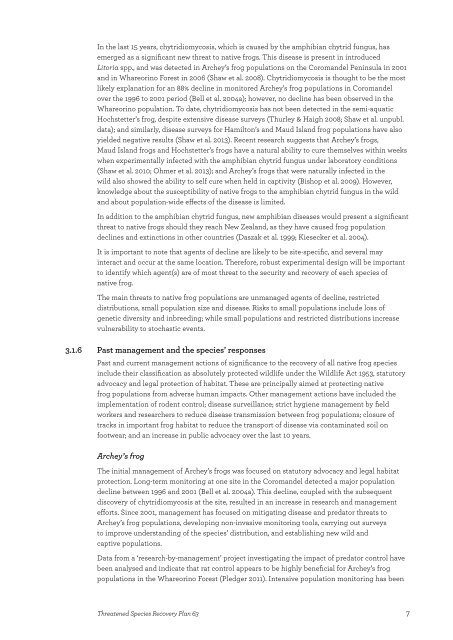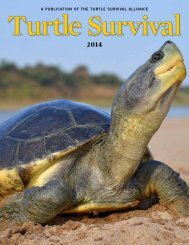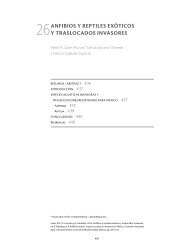tsrp63entire
tsrp63entire
tsrp63entire
Create successful ePaper yourself
Turn your PDF publications into a flip-book with our unique Google optimized e-Paper software.
In the last 15 years, chytridiomycosis, which is caused by the amphibian chytrid fungus, has<br />
emerged as a significant new threat to native frogs. This disease is present in introduced<br />
Litoria spp., and was detected in Archey’s frog populations on the Coromandel Peninsula in 2001<br />
and in Whareorino Forest in 2006 (Shaw et al. 2008). Chytridiomycosis is thought to be the most<br />
likely explanation for an 88% decline in monitored Archey’s frog populations in Coromandel<br />
over the 1996 to 2001 period (Bell et al. 2004a); however, no decline has been observed in the<br />
Whareorino population. To date, chytridiomycosis has not been detected in the semi-aquatic<br />
Hochstetter’s frog, despite extensive disease surveys (Thurley & Haigh 2008; Shaw et al. unpubl.<br />
data); and similarly, disease surveys for Hamilton’s and Maud Island frog populations have also<br />
yielded negative results (Shaw et al. 2013). Recent research suggests that Archey’s frogs,<br />
Maud Island frogs and Hochstetter’s frogs have a natural ability to cure themselves within weeks<br />
when experimentally infected with the amphibian chytrid fungus under laboratory conditions<br />
(Shaw et al. 2010; Ohmer et al. 2013); and Archey’s frogs that were naturally infected in the<br />
wild also showed the ability to self cure when held in captivity (Bishop et al. 2009). However,<br />
knowledge about the susceptibility of native frogs to the amphibian chytrid fungus in the wild<br />
and about population-wide effects of the disease is limited.<br />
In addition to the amphibian chytrid fungus, new amphibian diseases would present a significant<br />
threat to native frogs should they reach New Zealand, as they have caused frog population<br />
declines and extinctions in other countries (Daszak et al. 1999; Kiesecker et al. 2004).<br />
It is important to note that agents of decline are likely to be site-specific, and several may<br />
interact and occur at the same location. Therefore, robust experimental design will be important<br />
to identify which agent(s) are of most threat to the security and recovery of each species of<br />
native frog.<br />
The main threats to native frog populations are unmanaged agents of decline, restricted<br />
distributions, small population size and disease. Risks to small populations include loss of<br />
genetic diversity and inbreeding; while small populations and restricted distributions increase<br />
vulnerability to stochastic events.<br />
3.1.6 Past management and the species’ responses<br />
Past and current management actions of significance to the recovery of all native frog species<br />
include their classification as absolutely protected wildlife under the Wildlife Act 1953, statutory<br />
advocacy and legal protection of habitat. These are principally aimed at protecting native<br />
frog populations from adverse human impacts. Other management actions have included the<br />
implementation of rodent control; disease surveillance; strict hygiene management by field<br />
workers and researchers to reduce disease transmission between frog populations; closure of<br />
tracks in important frog habitat to reduce the transport of disease via contaminated soil on<br />
footwear; and an increase in public advocacy over the last 10 years.<br />
Archey’s frog<br />
The initial management of Archey’s frogs was focused on statutory advocacy and legal habitat<br />
protection. Long-term monitoring at one site in the Coromandel detected a major population<br />
decline between 1996 and 2001 (Bell et al. 2004a). This decline, coupled with the subsequent<br />
discovery of chytridiomycosis at the site, resulted in an increase in research and management<br />
efforts. Since 2001, management has focused on mitigating disease and predator threats to<br />
Archey’s frog populations, developing non-invasive monitoring tools, carrying out surveys<br />
to improve understanding of the species’ distribution, and establishing new wild and<br />
captive populations.<br />
Data from a ‘research-by-management’ project investigating the impact of predator control have<br />
been analysed and indicate that rat control appears to be highly beneficial for Archey’s frog<br />
populations in the Whareorino Forest (Pledger 2011). Intensive population monitoring has been<br />
Threatened Species Recovery Plan 63<br />
7





